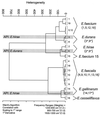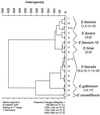Classification and identification of enterococci: a comparative phenotypic, genotypic, and vibrational spectroscopic study
- PMID: 11325987
- PMCID: PMC88022
- DOI: 10.1128/JCM.39.5.1763-1770.2001
Classification and identification of enterococci: a comparative phenotypic, genotypic, and vibrational spectroscopic study
Abstract
Rapid and accurate identification of enterococci at the species level is an essential task in clinical microbiology since these organisms have emerged as one of the leading causes of nosocomial infections worldwide. Vibrational spectroscopic techniques (infrared [IR] and Raman) could provide potential alternatives to conventional typing methods, because they are fast, easy to perform, and economical. We present a comparative study using phenotypic, genotypic, and vibrational spectroscopic techniques for typing a collection of 18 Enterococcus strains comprising six different species. Classification of the bacteria by Fourier transform (FT)-IR spectroscopy in combination with hierarchical cluster analysis revealed discrepancies for certain strains when compared with results obtained from automated phenotypic systems, such as API and MicroScan. Further diagnostic evaluation using genotypic methods-i.e., PCR of the species-specific ligase and glycopeptide resistance genes, which is limited to the identification of only four Enterococcus species and 16S RNA sequencing, the "gold standard" for identification of enterococci-confirmed the results obtained by the FT-IR classification. These results were later reproduced by three different laboratories, using confocal Raman microspectroscopy, FT-IR attenuated total reflectance spectroscopy, and FT-IR microspectroscopy, demonstrating the discriminative capacity and the reproducibility of the technique. It is concluded that vibrational spectroscopic techniques have great potential as routine methods in clinical microbiology.
Figures




References
-
- Bouhedja W, Sockalingum G D, Pina P, Allouch P, Bloy C, Labia R, Millot J M, Manfait M. ATR-FTIR spectroscopic investigation of E. coli transconjugants beta-lactams-resistance phenotype. FEBS Lett. 1997;412:39–42. - PubMed
-
- Bryce E A, Zemcov S J, Clarke A M. Species identification and antibiotic resistance patterns of the enterococci. Eur J Clin Microbiol Infect Dis. 1991;10:745–747. - PubMed
-
- Buschelman B J, Bale M J, Jones R N. Species identification and determination of high-level aminoglycoside resistance among enterococci. Comparison study of sterile body fluid isolates, 1985–1991. Diagn Microbiol Infect Dis. 1993;16:119–122. - PubMed
Publication types
MeSH terms
Substances
LinkOut - more resources
Full Text Sources

